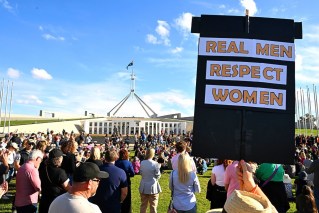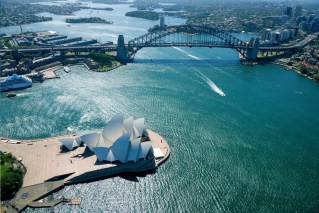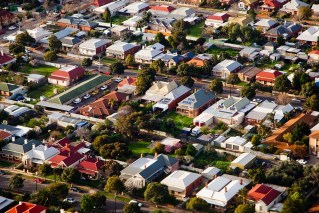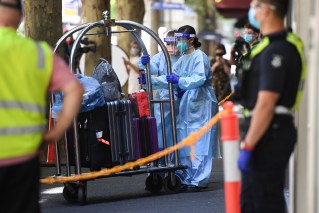Australia will join the global response to a rare powerful earthquake that struck Turkey and Syria, with a promise of $10 million through humanitarian agencies.
The fast-rising death toll grew further on Tuesday to 3700, but the World Health Organisation warned that could increase eight-fold.
The magnitude 7.8 quake rippled through both countries early on Monday, toppling entire apartment blocks, wrecking hospitals, and leaving thousands more people injured or homeless.
The New York Times reported that 3000 buildings crumbled, many flattening like pancakes as people slept.
Nearly 8000 people have been rescued from 4758 buildings destroyed in the tremors, Turkey’s Disaster and Emergency Management Authority said in its latest statement.

It’s reported that 3000 buildings collapsed in Turkey. Photo: Getty
AFAD head Yunus Sezer said 2921 people had died in Turkey as aftershocks continued to shake the region. Another earthquake of 5.6 magnitude struck central Turkey on Tuesday, the European Mediterranean Seismological Centre (EMSC) said.
Freezing winter weather hampered search efforts for survivors through the night.. Temperatures fell close to freezing overnight, worsening conditions for people trapped under rubble or left homeless.
Australia’s assistance will be administered through the Red Cross and humanitarian agencies.
The number of Australians affected remains unknown.
Prime Minister Anthony Albanese conveyed Australia’s condolences, saying the nation was deeply saddened by the tragic loss of life and devastation unfolding.
“All of the world’s thoughts and condolences with the people in this region who are suffering at this time,” he said.
New Zealand will also provide $1.5 million.
It comes as the WHO warned rescuers were in a race against time to find survivors because of extreme weather conditions, including freezing temperatures, snow, rain and wind.
Tweet from @AlboMP
Why was the quake so deadly?
The first magnitude 7.8 quake in Turkey early on Monday (local time) brought down whole apartment blocks and piled more devastation on millions of Syrians displaced by years of war.
It was followed in the early afternoon by another large 7.7 quake and numerous strong aftershocks.
Usually, powerful earthquakes happen under the ocean, according to siesmologists, but this one happened on land near densely populated cities.
The epicentre was fairly shallow, just 18 kilometres below the Earth’s surface.
The earthquake was the biggest recorded worldwide by the US Geological Survey since a tremor in the remote South Atlantic in August 2021.
It was the deadliest earthquake in Turkey since a quake of similar magnitude in 1999 that killed more than 17,000. Nearly 16,000 were reported injured in Monday’s quake.
Turkish President Tayyip Erdogan, preparing for a tough election in May, called the quake a historic disaster and said authorities were doing all they could.
“Everyone is putting their heart and soul into efforts although the winter season, cold weather and the earthquake happening during the night makes things more difficult,” he said, adding that 45 countries had offered to help the search and rescue efforts.
At least 1444 people were killed in Syria and about 3500 injured, according to figures from the Damascus government and rescue workers in the north-western region controlled by insurgents.
In Syria, the effects of the quake were compounded by the destruction of more than 11 years of civil war.
A top United Nations humanitarian official said fuel shortages and the harsh winter weather were also creating obstacles to its response.
“The infrastructure is damaged, the roads that we used to use for humanitarian work are damaged, we have to be creative in how to get to the people… but we are working hard,” UN resident coordinator El-Mostafa Benlamlih told Reuters in an interview via video link from Damascus.
In the government-controlled city of Aleppo, footage on Twitter showed two neighbouring buildings collapsing one after the other, filling streets with billowing dust.
Two residents of the city, which has been heavily damaged in the war, said the buildings had fallen in the hours after the quake, which was felt as far away as Cyprus and Lebanon.
The Turkish city of Gaziantep, near the epicentre, was a boom city and concerns had reportedly been raised in the past about the quality of construction during the fast growth of the 1990s and early 2000s.

Police officer Zekeriya Yildiz hugs his daughter after she was saved from the rubble in Hatay. Photo: Getty
Seismologists said the earthquake occurred along a faultline between the Anatolian and Arabian techtonic plates. Jutting up against one another, the two plates slipped horizontally — what is known as a strike-slip quake.
The sliding motion — with one plate moving west while the other moved east — caused the earth to suddenly jerk as pressure was released.
The shaking in Turkey was felt for about two minutes.
A similar well-known fault that causes strike-slip earthquakes is California’s San Andreas fault that extends 1200 kilometres.
Seismologist Ross Stein told Scientific American that earthquakes of such magnitude in Turkey were rare — about a once in a century.
He said the No.1 reason for the high fatality rate was building quality.
“I don’t know if the buildings that fell (in the recent quake) are older buildings or poorer buildings, so I’m not accusing anybody of anything,” he said.
“But this is the problem worldwide, not just in Turkey.”







